Those of you who have followed my blogs over the years know how fond I am of noting that Xi’an in China was the capital for over 1000 years, most recently 1000 years ago. Imagine my joy in being in Istanbul, which for over 1000 years was the new “Rome” (under the name Constantinople), and for the next nearly 500 years, as Istanbul, was home to the “Scourge of Europe.” It’s pretty obvious that whoever wrote the song which gave the title to this blog entry was drawing on the creation of the Turkish Republic from the wreckage of the Ottoman Empire in 1923. All three parts of this brief history are apparent in this city of 15 million that spans two continents (East of the Bosphorus is Asia Minor, which as I told a student is like Asia Major, but with 4 fewer classes; that’s an IWU joke).
The efforts of Kemal Ataturk, who fought to reverse the Allied partition of Turkey after World War I, are obvious in his efforts to secularize a Muslim state. He abolished the Caliphate when the last religious leader of the Muslim world died in the early 1920s, and as we walked the city today, while some were in traditional garb, most Turks wore more European dress; also, it was Sunday, the day of rest in Turkey, but not much of the Muslim world. Many of the churches, which Mehmet the Conqueror (the 21 year old Sultan who led the troops that captured Constantinople in May 1453) turned into mosques (including Hagia Sophia, which we’ll see in the next few days) became museums. And people smoke and drink (though the pastry shops far outnumber the bars), which again is not common in the Middle East. Turkey is a secular Muslim country.
The Byzantine period lasted over 1000 years, from Constantine, the Roman Emperor who founded it early in the 4th century, through 1453, when Constantine XI Palaeologus died fighting the Turks. The remains abound, 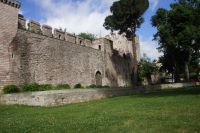 and one of the purposes of my aftertour is to visit the Byzantine remains. One of them is obvious from the ride in from the airport—much of the massive fortification is still present. Indeed, the conquest of the city required a major siege, some subterfuge (the Byzantines chained the river to prevent the Ottoman navy from joining the battle; Mehmet hauled the ships overland and bypassed the chains); and some strange behavior (a Christian cannonier offered his services in making a huge cannon to the Byzantines).
and one of the purposes of my aftertour is to visit the Byzantine remains. One of them is obvious from the ride in from the airport—much of the massive fortification is still present. Indeed, the conquest of the city required a major siege, some subterfuge (the Byzantines chained the river to prevent the Ottoman navy from joining the battle; Mehmet hauled the ships overland and bypassed the chains); and some strange behavior (a Christian cannonier offered his services in making a huge cannon to the Byzantines).
Broke—partly because of the fourth crusade, when the overzealous crusaders sacked and occupied Constantinople—the source of much of Venice’s wealth, including the famous horses in St. Mark’s, Byzantium never recovered. By 1453, the Eastern Roman Empire had pretty much been reduced to the city of Constantinople and its environs. Rejected by the Byzantines, the Christian cannon builder offered his services to Mehmet, who thus acquired the firepower needed to breach the walls.
Many of the churches and mosaics remain from the Byzantine period, and I am especially eager to see the Chora Church and the Archeological museum (the Hittites were here, too), and the underground cistern system. The old aqueduct still stands—a testimony to Roman engineering. Indeed, one of the major accomplishments of the Byzantine Empire was in keeping the barbarians out of Europe, with the exception of the Mongols; Greek scholars also kept alive Greco-Roman philosophy and literature at a time when Europe was in the Dark Ages.
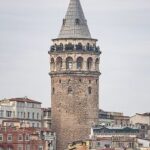 When the Turks actually bore down on Constantinople, the Emperor offered to convert to Catholicism if the European countries would send troops. Perhaps if there’d been an EU in 1450, it’d still be Constantinople! I saw another reminder of the cosmopolitan nature of the city under the
When the Turks actually bore down on Constantinople, the Emperor offered to convert to Catholicism if the European countries would send troops. Perhaps if there’d been an EU in 1450, it’d still be Constantinople! I saw another reminder of the cosmopolitan nature of the city under the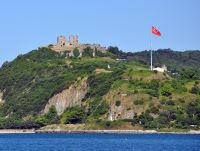 Byzantines—the Galata Tower and the Yoros Castle (at the end of the Bosporus—more later on that) which were defended by the Venetians and Genoans who lived in the city, and whose trade was so important to the Byzantines and to the West. Indeed, Constantinople at one time was one of the termini of the Silk Road to China.
Byzantines—the Galata Tower and the Yoros Castle (at the end of the Bosporus—more later on that) which were defended by the Venetians and Genoans who lived in the city, and whose trade was so important to the Byzantines and to the West. Indeed, Constantinople at one time was one of the termini of the Silk Road to China.
The role of the Osman family (Ottoman) is the most pronounced in terms of tourist sites, and the history and culture of contemporary Turkey. At varying times cosmopolitan (the Ottomans welcomed Jews driven from Spain, and the physicians to the Sultans were usually Jewish), it’s sometimes difficult to remember how rich the country was—though it is easily remembered how powerful it was. Suleyman’s defeat at the gates of Vienna marked the westward limits of Turkish conquests, but I’ve seen battlefields in Poland and Russia, and indications of the occupation of the Balkans, Greece, and Hungary that are neither forgotten nor forgiven. We will be seeing the Topkapi Palace tomorrow, which should give our students some insight into what being rich meant in the 16th and 17th centuries. It helped Professor Pana and I to understand it when we went to a “traditional restaurant” whose recipes were based on the cookbook of Mehmet II. As we sat in the shadow of Hagia Sophia, we ate like a king for a night. We’ve set up a “farewell dinner” in a similar restaurant tomorrow, near the Chora Church with its world famous mosaics.
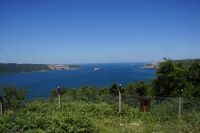
We got a look at the city and the Bosporus on a tour today, a four hour ferry 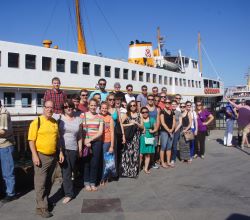 ride to the Black Sea.
ride to the Black Sea.
The importance of Constantinople/Istanbul, economically, is that it links the Russian breadbasket and the Mediterranean worlds. The progression of the summer palaces north of the city—built by Sultans and grand viziers, mostly—showed the increasing wealth of the country. The forts along the way revealed the importance to Turkey (and the Ottomans and the Byzantines) of guarding this “competitive advantage.” Russia’s quest for open ports to the south framed much of Russian history, certainly from Catherine the Great (who captured the Crimea from Muslims, thereby depriving the Ottoman armies of the best cavalry in the world) to Putin today.
Speaking of Russia (and the EU), Putin, when asked whether Russia would join the EU, reputedly said, “The EU should join us.” We hope to get more information on Turkey tomorrow.